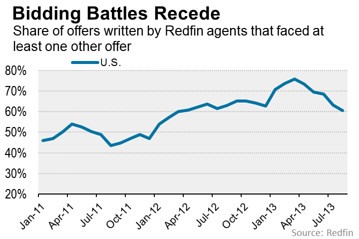For the past year, more U.S. housing markets have had the feel of a blowout flea-market sale.
Prices were low and financing—while hard to get—was cheap for those who could get it. Once it was clear prices had found a bottom, bidding wars broke out as buyers competed over a shrinking supply of homes to get a good deal.
That sent prices up—sharply, in many markets—and for a while, buyers didn’t much mind. Falling interest rates made it possible for buyers to offer slightly higher prices without raising their monthly ownership costs.
But now, mortgage rates are up by a full percentage point over the past four months, and affordability has taken a hit, prompting concerns about a short-term “soft patch” as buyers and sellers adjust. Here’s a look at four keys to the housing puzzle:
1. Housing became less affordable in a short span. Typically in a recovery, sales pick up and then prices follow. But the current recovery has been “flip-flopped,” said Ivy Zelman, chief executive of Zelman & Associates Inc., a research and advisory firm. “We’ve had pricing accelerate out of the box” as builders took advantage of rising demand and low interest rates while adding little in the way of new construction. “That’s not typical of an upturn.”
Now, with prices up by double-digits from one year ago, rising rates have been “almost like a red light on the frantic price inflation,” said Ms. Zelman. A Zelman report last week showed that new home orders in August rose by just 1% from one year earlier, compared to year-over-year gains of 11% in July and 25% during the second quarter. “I hear more often now from builders, ‘We pushed prices too far,’” she said. “Consumers got sticker shock.”
2. Inventories are still depressed. Demand is only part of the equation of course, and some real-estate agents say the biggest drag on sales continues to be the lack of homes for sale. While the number of listings in August was up by 20% from the beginning of the year, the supply of homes for sale is below the already-depressed levels of one year ago. “There’s just not enough inventory to justify price declines,” said Ms. Zelman.
Buyers are also being pickier today because they’re looking for a home that they can live in for a long time, said Jim Klinge, a real-estate agent in Carlsbad, Calif. “Buyers want the right house,” he said. “They’ll pay more for it, and they’ll pay a higher rate.” But if it’s not available, they’ll wait.
Data tracked by John Burns Real Estate Consulting shows that in the vast majority of the nation’s 20 top markets, demand exceeds supply. In Phoenix, new-home sales are being hindered by a lack of supply, said Mike Orr, a housing analyst at Arizona State University in Tempe, Ariz. “There’s not any new homes in the places where people want to live,” he said. “People are frustrated.”
3. This should help quiet the bubble talk. Earlier this year, some worried that the housing market was back in a bubble. Any cooling down should soothe those worries. “I was more scared of the market at the beginning of the year than I am right now, because I knew that was not sustainable,” said Greg Markov, a real-estate agent in Phoenix, a market at the center of the home-price rebound over the past year.
“People were behaving irrationally, and it set us up for more ups and downs,” said Glenn Kelman, chief executive at Redfin, the real-estate brokerage.
While incomes have been growing at roughly 1% a year, home prices have been rising much faster—by around 12% nationally. Some of this happened because home prices had fallen below their traditional relationship with incomes. But a 12% pace of growth was “simply too high and not sustainable,” said Chris Flanagan, a mortgage analyst at Bank of America Merrill Lynch in a recent report.
4. How smooth a hand-off? As rising prices ease investors out of more markets, there will be less competition for some homes, slowing the pace at which prices are going up. The key going forward is how well owner-occupant, mortgage-dependent buyers are able to pick up the slack from investors, especially in an environment where rates are rising.
Unemployment is still high, especially among younger workers who would normally be first-time home buyers. Mortgage credit remains tight, and many borrowers may already have high debt loads or irregular incomes that make them marginal candidates for a loan anyway.
When interest rates normalize, “any future improvement in housing will be entirely dependent on the jobs picture,” said Jeffrey Otteau, chief executive of Otteau Valuation Group, an appraisal firm in East Brunswick, N.J. The key, he adds, is how many jobs are being added “and are they part time temporary contract workers at the bottom of the income ladder or are they the high paying jobs we need to sustain a housing recovery?”
The answer to that question will go a long way towards clarifying how fast housing heals.




